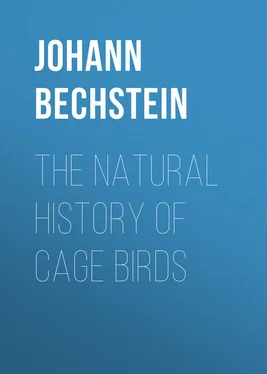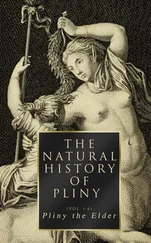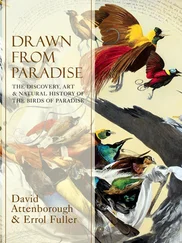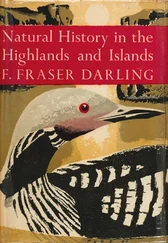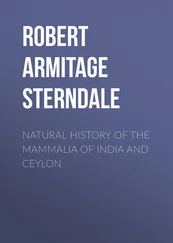Johann Bechstein - The Natural History of Cage Birds
Здесь есть возможность читать онлайн «Johann Bechstein - The Natural History of Cage Birds» — ознакомительный отрывок электронной книги совершенно бесплатно, а после прочтения отрывка купить полную версию. В некоторых случаях можно слушать аудио, скачать через торрент в формате fb2 и присутствует краткое содержание. ISBN: , Жанр: foreign_antique, foreign_prose, на английском языке. Описание произведения, (предисловие) а так же отзывы посетителей доступны на портале библиотеки ЛибКат.
- Название:The Natural History of Cage Birds
- Автор:
- Жанр:
- Год:неизвестен
- ISBN:http://www.gutenberg.org/ebooks/40055
- Рейтинг книги:4 / 5. Голосов: 1
-
Избранное:Добавить в избранное
- Отзывы:
-
Ваша оценка:
- 80
- 1
- 2
- 3
- 4
- 5
The Natural History of Cage Birds: краткое содержание, описание и аннотация
Предлагаем к чтению аннотацию, описание, краткое содержание или предисловие (зависит от того, что написал сам автор книги «The Natural History of Cage Birds»). Если вы не нашли необходимую информацию о книге — напишите в комментариях, мы постараемся отыскать её.
The Natural History of Cage Birds — читать онлайн ознакомительный отрывок
Ниже представлен текст книги, разбитый по страницам. Система сохранения места последней прочитанной страницы, позволяет с удобством читать онлайн бесплатно книгу «The Natural History of Cage Birds», без необходимости каждый раз заново искать на чём Вы остановились. Поставьте закладку, и сможете в любой момент перейти на страницу, на которой закончили чтение.
Интервал:
Закладка:
London,
November 1837 .
INTRODUCTION
By cage birds, I mean those kept by amateurs, for amusement, in their apartments, generally selected for sweetness of song or beauty of plumage; but the naturalist has other reasons for surrounding himself with these pleasing creatures: they enliven him, and he delights in studying their habits and characters. To attain these objects it is necessary, in the first place, to be able to distinguish readily between the males and females, since the former are generally superior in their powers of song, and therefore preferable. I have, for this reason, made a point, in the following sketch of the history of house birds, of showing the colours and other marks which characterise the two sexes; and, as all birds cannot be tamed, whilst many others offer no inducement to make the attempt, it follows that those about to be spoken of must necessarily be but a small proportion of all the known species of birds.
SONGS OF TAME BIRDS
What is most prized and admired in house birds is undoubtedly their song. This may be natural or artificial, the former being as varied as the species of the birds, for I know of no two indigenous species quite similar in their song; I ought, perhaps, to except the three species of shrike I have given, which, from their surprising memory, can imitate the songs of other birds so as to be mistaken for them: but a naturalist would soon perceive a slight mixture of the song natural to the imitator, and thus easily distinguish between the shrike that copied, and the titlark or red-breast copied from 1 1 See reasons for doubting this conclusion in Professor Rennie’s Domestic Habits of Birds, Chap. xvii. – Translator.
. It is so much the more important to be well versed in the different birds’ songs, as to this knowledge alone we are indebted for several curious observations on these pretty creatures.
An artificial song is one borrowed from a bird that the young ones have heard singing in the room, a person’s whistling, a flageolet, or a bird-organ. Nearly all birds, when young, will learn some strains of airs whistled or played to them regularly every day; but it is only those whose memory is capable of retaining these that will abandon their natural song, and adopt fluently, and repeat without hesitation, the air that has been taught them. Thus, a young goldfinch learns, it is true, some part of the melody played to a bullfinch, but it will never be able to render it as perfectly as this bird; a difference not caused by the greater or less suppleness of the organ, but rather by the superiority of memory in the one species over that of the other.
We distinguish in birds a chirping and warbling, or song, properly so called; besides this, several species, with a large, fleshy, undivided tongue, are able to repeat articulate sounds, and they are then said to talk , such as parrots and jays.
It is remarkable, that birds which do not sing all the year, such as the red-breast, siskin, and goldfinch, seem obliged, after moulting, to learn to warble, as though they had forgotten; but I have seen enough to convince me that these attempts are merely to render the larynx pliant, and are a kind of chirping, the notes of which have but little relation to the proper song; for a slight attention will discover that the larynx becomes gradually capable of giving the common warble.
This method of recovering the song does not then show deficiency of memory, but rigidity occasioned by the disuse of the larynx. The chaffinch will exercise itself in this way some weeks before it attains its former proficiency, and the nightingale practises as long the strains of his beautiful song, before he gives it full, clear, and in all its extent 2 2 This previous recording, as it is termed, is not uniform. Mr. Blyth informs as that he had, in the year 1833, a blackcap which struck up all at once into a loud song. – Translator.
.
The strength and compass of a bird’s voice depend on the size and proportionate force of the larynx. In the female it is weak and small, and this accounts for her want of song. None of our woodland songsters produces more striking, vigorous, and prolonged sounds than the nightingale; and none is known with so ample and strong a larynx: but as we are able to improve the organisation of the body by exercise and habit, so may we strengthen and extend the larynx of several birds of the same species, so as to amplify the song in consequence, by more nutritive food, proper care, sounds that excite emulation, and the like; chaffinches, bullfinches, canaries, and other birds reared in the house, furnish daily examples of this.
I should not omit mentioning here an observation of Mr. Daines Barington 3 3 Phil. Trans. vol. lxiii. 1773.
, which tends to prove the possibility of improving the song of wild birds, by rearing linnets, sparrows, and others, near some good warbler, such as a nightingale or canary, and then setting them at liberty; but, though there is some truth in this assertion, yet it is subject to certain restrictions. I only know of two ways of carrying this idea into execution; one by suspending the cages of the best warblers in the orchard where the birds which they are to teach breed; the other, to enclose these warblers in a large aviary of iron wire, in the open air. There let them teach their young ones, which may be set at liberty as soon as they are able to fly: but birds taken very young from the nest, and reared, formed, and educated in the house, would not have instinct to find their food when set at liberty, and must perish of hunger, or at least die in the winter.
The same remarks are applicable to a work published by M. Gambory at Copenhagen, in the year 1800.
I think, indeed, it is better to be contented with possessing in our houses artificial songs than to take so much trouble to alter and spoil the very delightful music of nature 4 4 Besides, we cannot say that there is a want of variety in this music. I may again quote Mr. Barington (Phil. Trans.): “The death of the male parent, just at the time his instructions were required, will occasion some variety in the song of the young ones, who will thus have their attention directed to other birds, which they will imitate or modify according to the conformation of their larynx; and they will thus create new variations, which will afterwards be imitated by their young ones, and become hereditary, until a circumstance of a similar nature may introduce greater variations. If care was taken there need not be two birds that sung exactly alike: however, these varieties are confined within certain limits.” – Translator.
.
HABITATIONS OF TAME BIRDS
The space assigned to tame birds varies according to their nature and destination. All are less at ease in a cage than when at liberty in a room, where young pine branches, cut in winter or early in spring, should be placed for their accommodation 5 5 If pine and fir branches cannot be obtained, oak, elm, or beech will do, cut in winter; though not green, yet there will be leaves. – Translator.
. Several, however, never sing unless confined within narrow limits, being obliged, as it would appear, to solace themselves, for the want of liberty, with their song; consequently, birds only prized for the beauty of their plumage or their pleasing actions, are best placed in a room. Rather large birds, such as thrushes, should have a room appropriated to them, or be kept in a large aviary, as they give a very unpleasant smell to the place which they occupy, unless carefully cleaned; but their young ones may be allowed the range of any apartment, placing in a corner a cage or branch to rest and sleep on, where they may run and hop freely, seeking a roosting-place for themselves in the evening, on the fir branches placed for that purpose; or in a cage with several divisions, into which they soon learn to retire. Some birds, such as the dunnock and the blue-breast, sing best in this state of liberty. It is necessary to avoid placing them with shrikes or tits, as these often, in the midst of plenty of food, will kill smaller birds, for the sake of eating the brain or intestines. Those that are confined that we may better enjoy the beauty of their song, should have a cage proportioned to their natural vivacity: a lark, for example, requires a larger cage than a chaffinch. The habits of the birds must also be considered, whether they rest on the ground or perch on sticks. Thus, the nightingale must have perches, while the sky-lark never makes use of these.
Интервал:
Закладка:
Похожие книги на «The Natural History of Cage Birds»
Представляем Вашему вниманию похожие книги на «The Natural History of Cage Birds» списком для выбора. Мы отобрали схожую по названию и смыслу литературу в надежде предоставить читателям больше вариантов отыскать новые, интересные, ещё непрочитанные произведения.
Обсуждение, отзывы о книге «The Natural History of Cage Birds» и просто собственные мнения читателей. Оставьте ваши комментарии, напишите, что Вы думаете о произведении, его смысле или главных героях. Укажите что конкретно понравилось, а что нет, и почему Вы так считаете.
